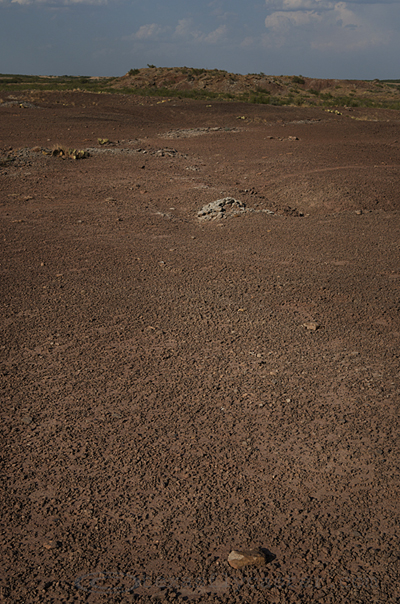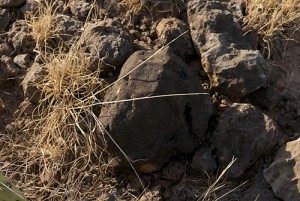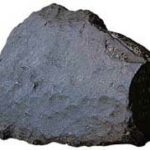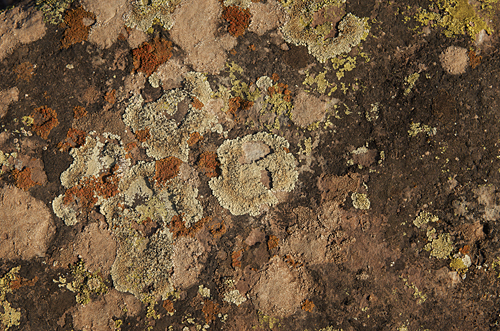Cosmic or Not Cosmic?

Space. The final frontier, or is it?
The Red River Meteorite
Meteorites may not have anything to do with fly fishing, but sometimes our vivid fascination can extend beyond the pescatorial palette. For instance, did you Texans know there is a famous meteorite named the Red River Meteorite? I wouldn’t have known it unless the legend hadn’t been told to me by a friend of mine out here in the Middle.
Now what brought up the story of the Red River Meteorite? For one, we aren’t far at all from the Red River, and for another there are strange sights to see if you get far enough off the tracks. Whether or not he stumbled onto the actual site of the meteorite, a fragment, or the location is a simple twist of geologic fate, we don’t yet know.

According to a local rancher, nothing has ever grown here.
I visited the site the day before leaving the Middle, and when I got to the landing zone, it definitely shows signs of being different from its surroundings. As I walked around the mound in one area, I fully expected Gus and Call (read Lonesome Dove) to be sitting on a rock around the corner, turn their heads and casually ask what took me so long to get there. This place is that rough and that remote. Except for the game trails through the area, cow patties, and tough mesquites, you could almost pass it off for a martian landscape. Not a drop of water for miles.
The landscape shows signs of high heat, clay cooked to porous lava-like bits of brick, and some small and very heavy “rocks” – several of which would fit in the palm of your hand. Whether or not these dense “rocks” are fragments of a fragment, or whether they are indigenous to the planet, whether they are radioactive, all are questions still to be answered by the experts. Other rocks, blatantly local, have a black tarred look to their tops, as if they were cooked on one side, while the unexposed side still looks just like a regular old rock. Those burned rocks are everywhere, and it doesn’t rub off as might happen if it were soot from a grass fire.

One of the “burned” rocks that litter the area.
The location is in the “vicinity” of where a fracture of the meteorite could have easily separated from the main object. The probable impact point of the main part of the meteorite is somewhere around Jacksboro, Texas, according to conventional legend.
 There are a couple of completely fascinating stories to go with the Red River Meteorite, starting with the Yale Peabody story of how “two rival expeditions were organized to retrieve it from the wilderness, each lead by a member of the original party that had seen it.”(1) The first group that got to the meteorite was not prepared to haul a 1600-plus pound and hid it until they could come back with a way to haul the mass. While the first group was reconnoitering for transportation, the second group arrived and finally found where the rock was buried, and managed to get it to the Red River where they floated it all the way to New Orleans, and then shipped it all the way to New York. Daunting.
There are a couple of completely fascinating stories to go with the Red River Meteorite, starting with the Yale Peabody story of how “two rival expeditions were organized to retrieve it from the wilderness, each lead by a member of the original party that had seen it.”(1) The first group that got to the meteorite was not prepared to haul a 1600-plus pound and hid it until they could come back with a way to haul the mass. While the first group was reconnoitering for transportation, the second group arrived and finally found where the rock was buried, and managed to get it to the Red River where they floated it all the way to New Orleans, and then shipped it all the way to New York. Daunting.
Once the meteorite was found to be only nickel and iron, it was relegated to a less favorable prominence, and was almost lost forever except for the effort the wife of Colonel Gibbs, who originally prevented the meteorite from being shipped to Europe and sold. She again rescued the meteorite, this time saving it from being buried, and donated it to Yale University, where it was the largest meteorite in any collection in the world for several years.(2)
Whether or not this location is related to that meteorite or not, is yet to be determined. What is known is that this site continues to baffle geologists who are posed with the unique set of samples found at this site. I know we have a few geologist fly fishers who read Texas Fly Caster, so if you have two-cents-worth, now is the time to throw your thinking cap into the ring. I never knew, until the end of researching this (once-over lightly) that there was a southern expedition by Freeman & Custis, launched at the same time as Lewis & Clarke’s more successful expedition – see Amazon Book at bottom. I haven’t delved into the book, but as it comes up in reference to the Red River Meteorite, this must have been the expedition that discovered the meteorite.
I thought it would be interesting to show how the normal can become cosmic – even in photography. The top image and the last image are the same, but a little Adobe Photoshop adds a cosmic appearance to the mundane lichen found on one of the rocks at the site. I guess the jury will be out on whether this place has a cosmic connection until science decides to take a look at a desolate spot out in the Middle.
Thanks for riding out a five week stint out in the Middle of Texas with me! This entry marks the last from the Middle, and I hope you enjoyed getting off topic while Texas burned.
It did rain in North Texas yesterday, and I did fish a little to sharpen up for the upcoming trip to Grand Isle, Louisiana.
reference – (1,2) Yale University – http://peabody.yale.edu/collections/met/met_redriver.html Paraphrased and quoted directly in this post.


You must be logged in to post a comment.